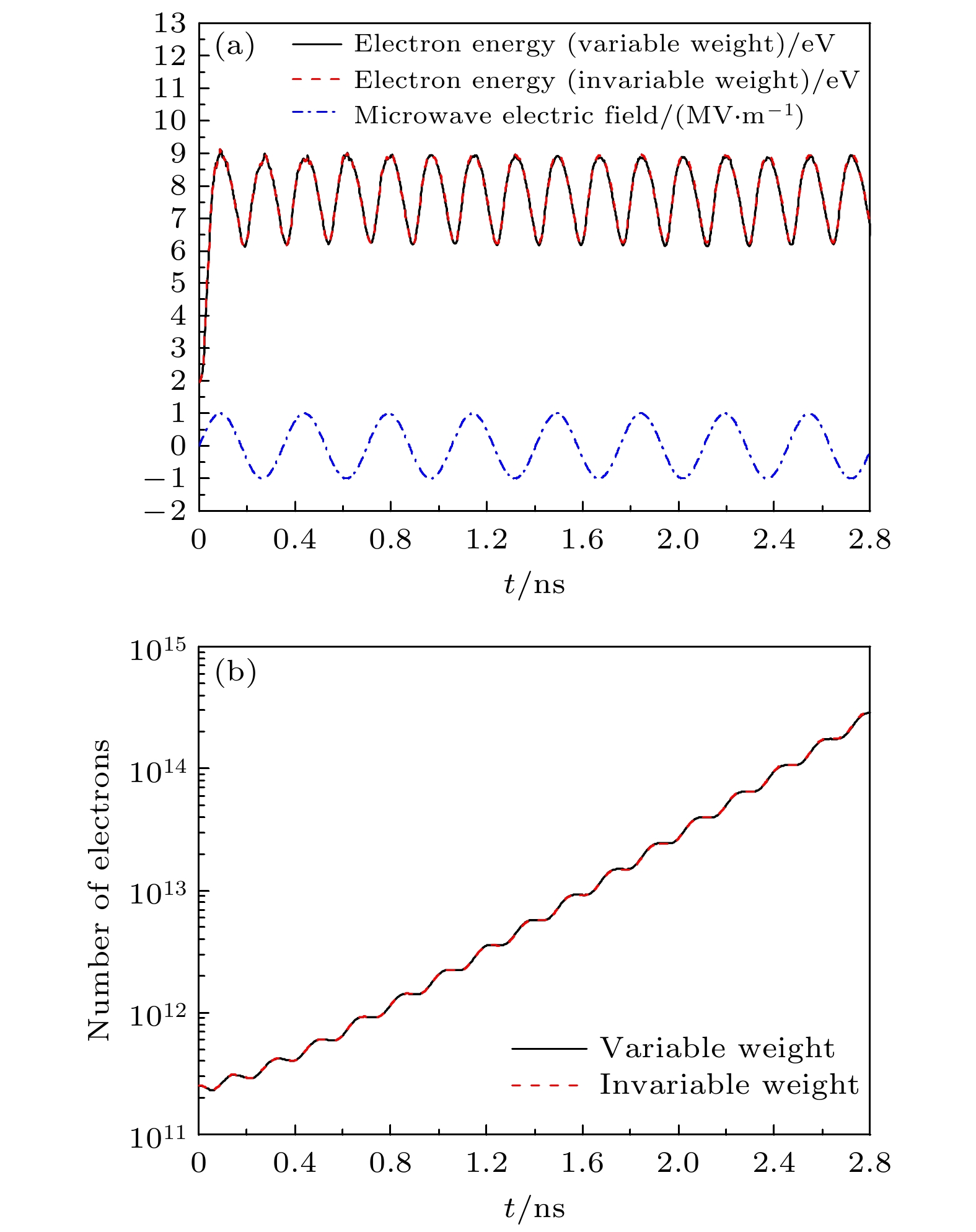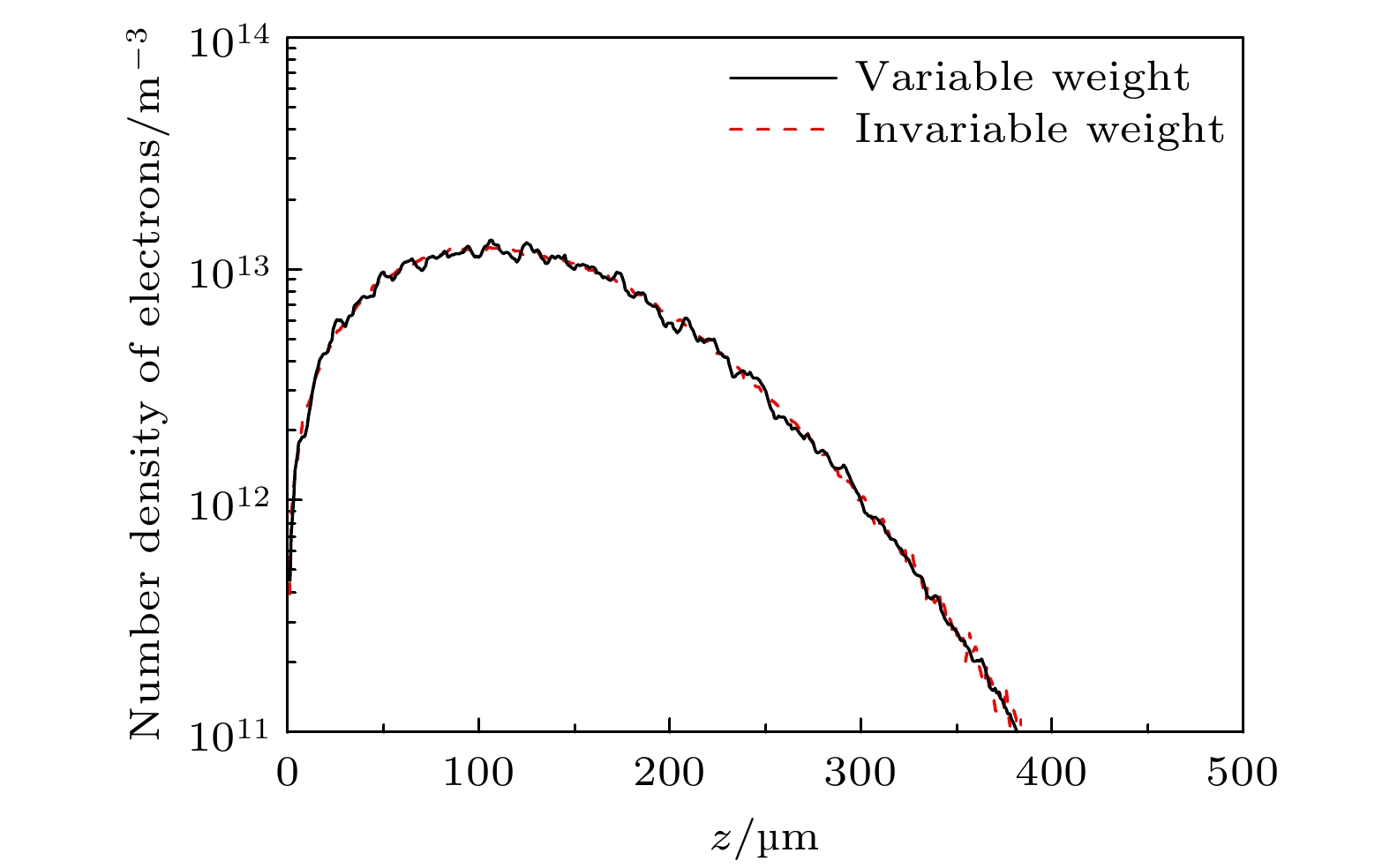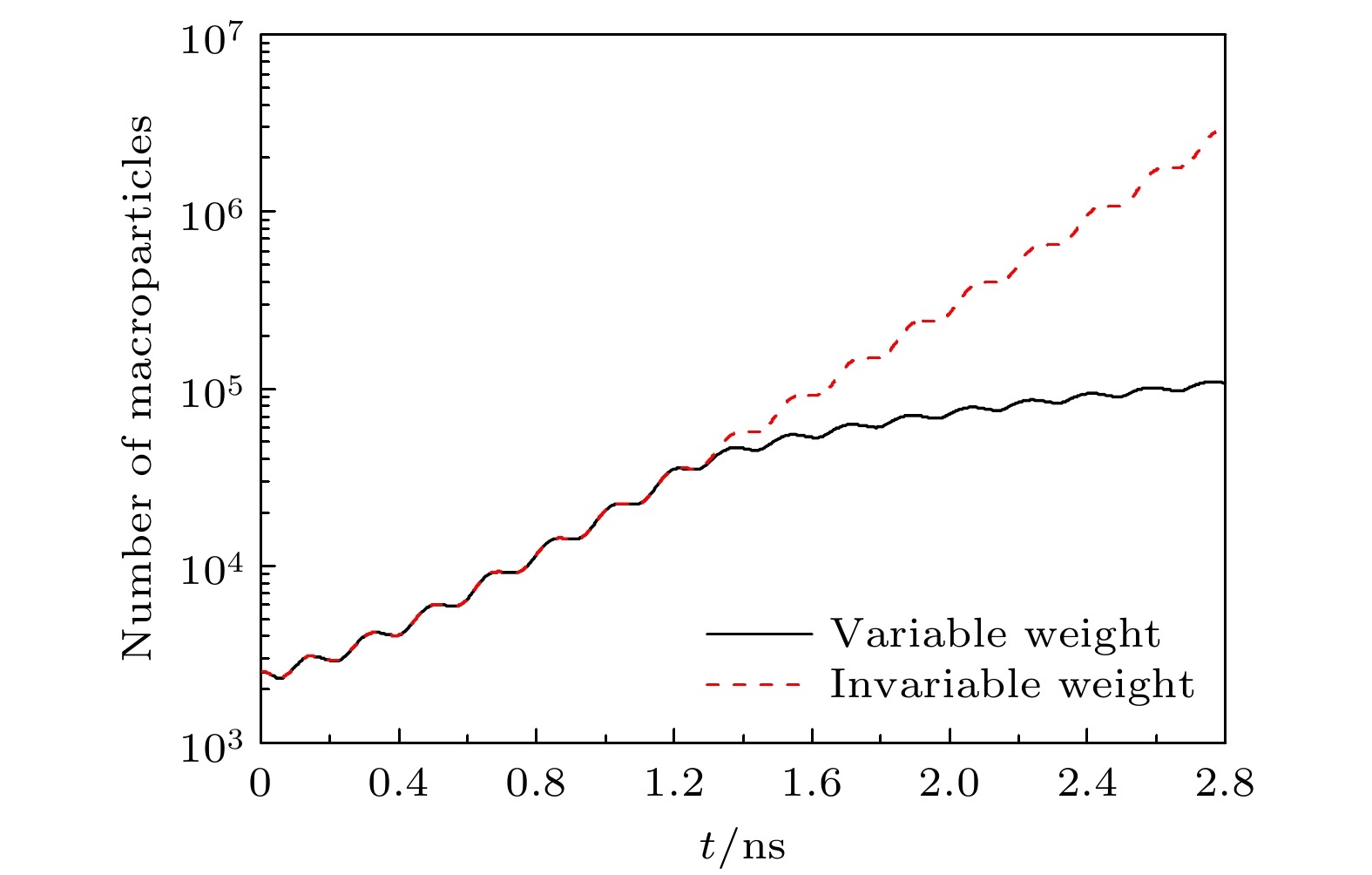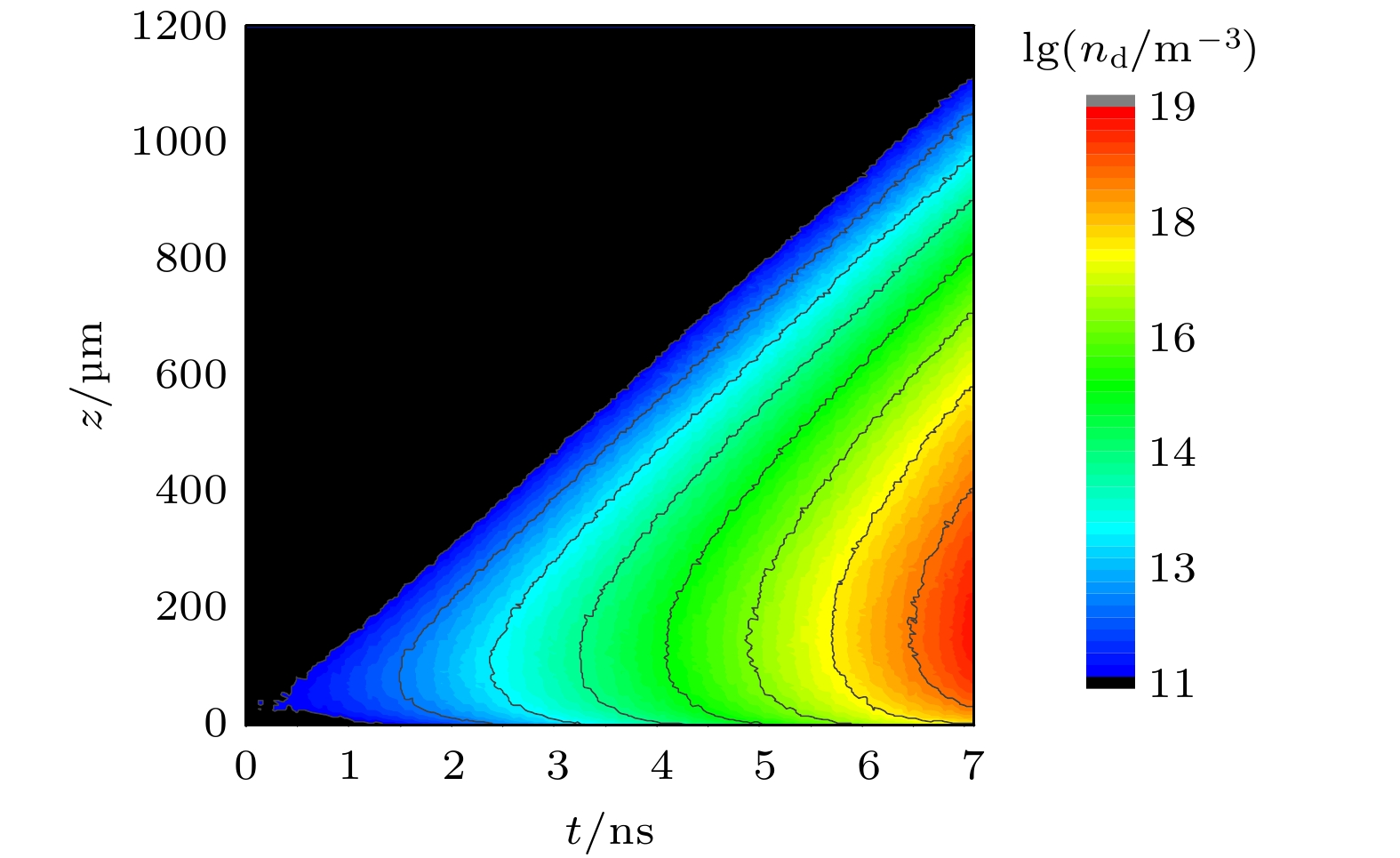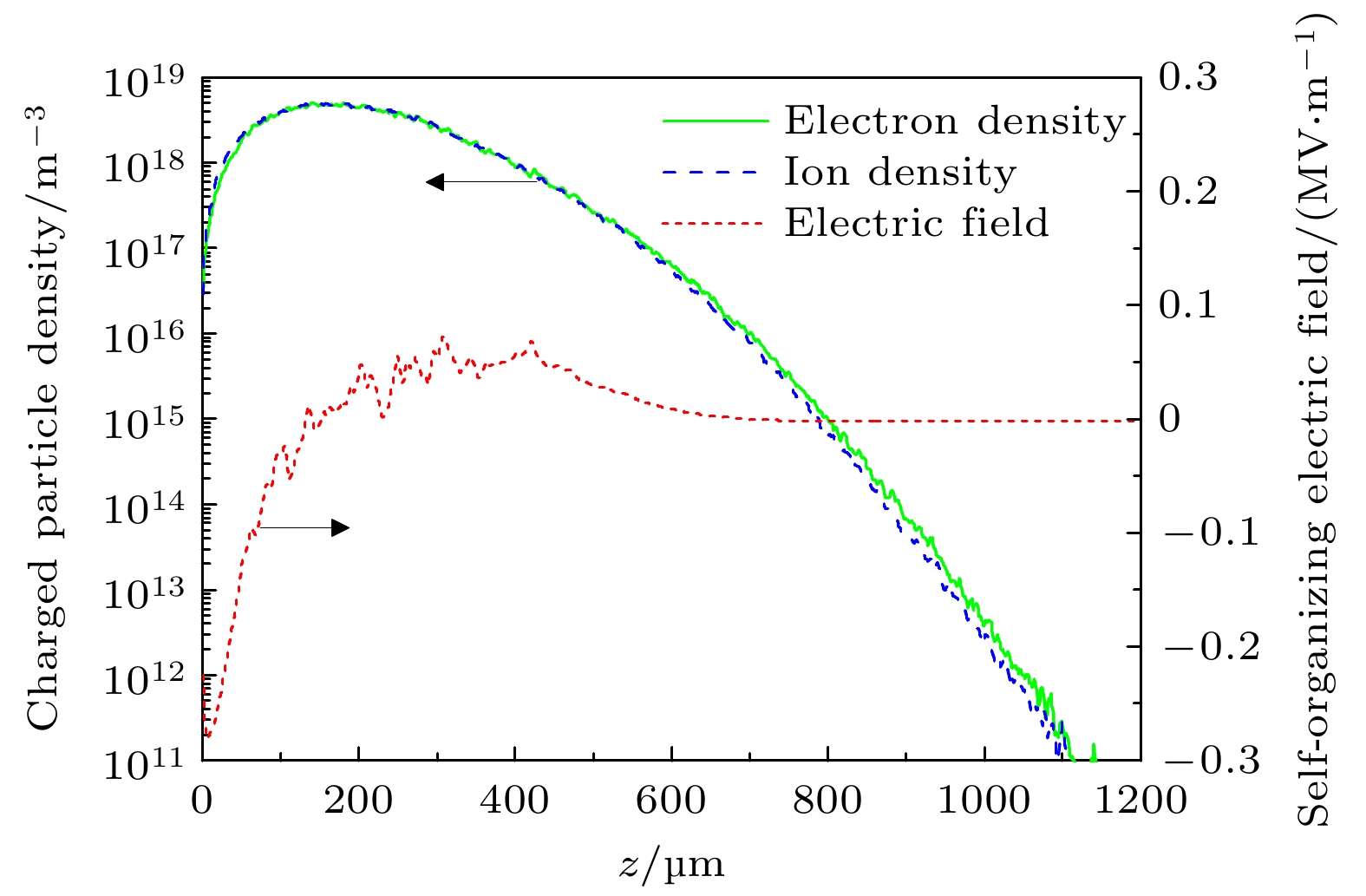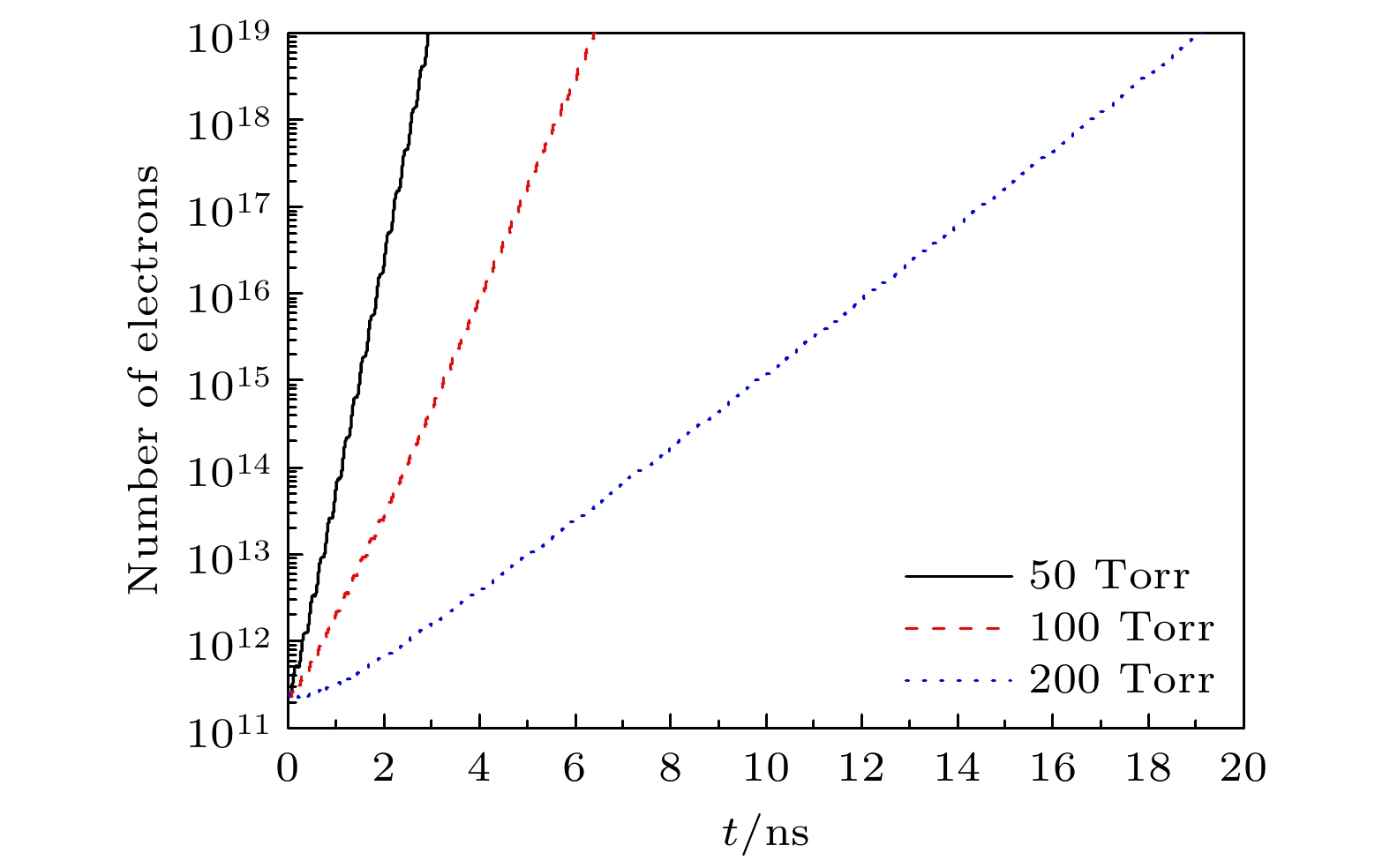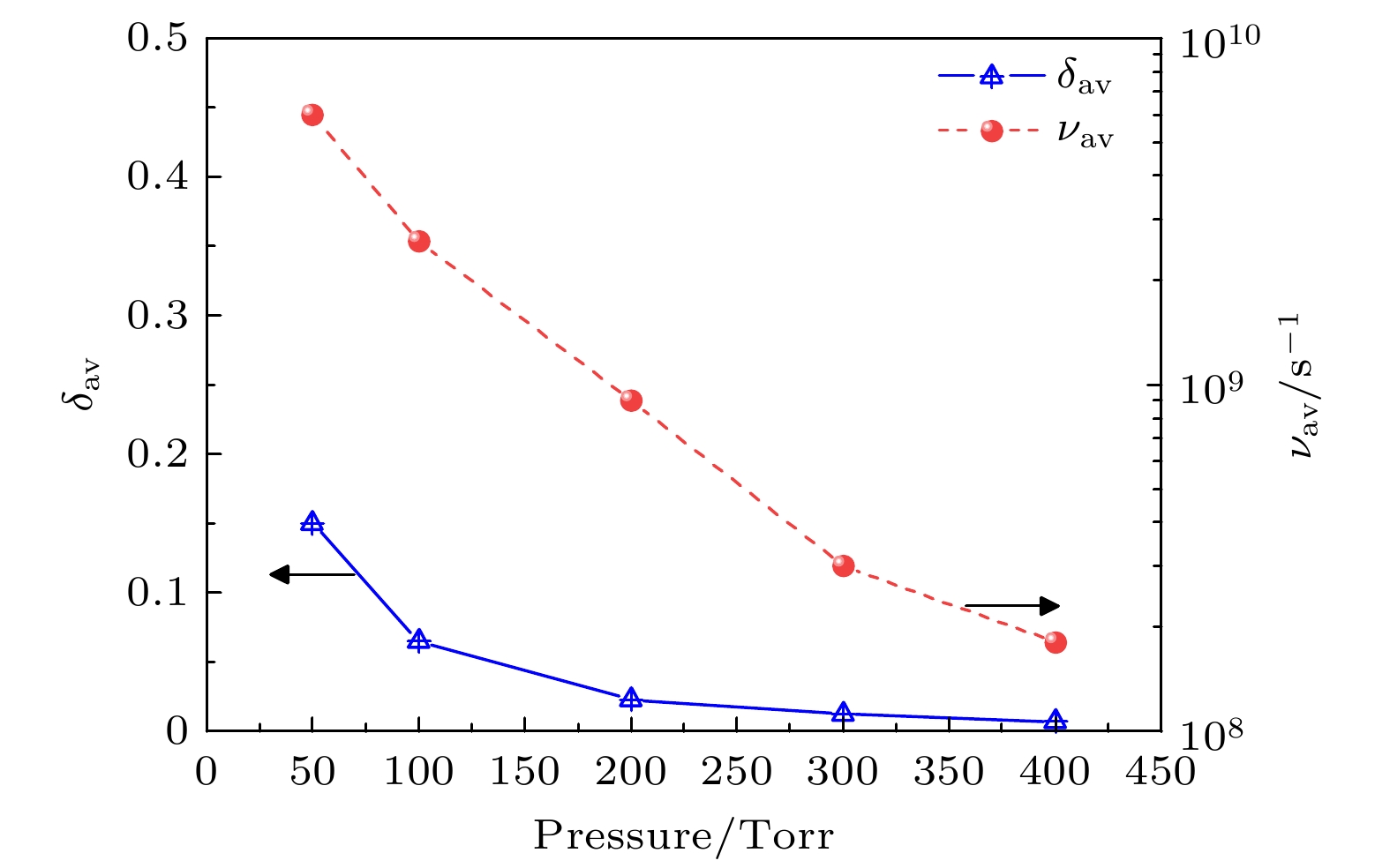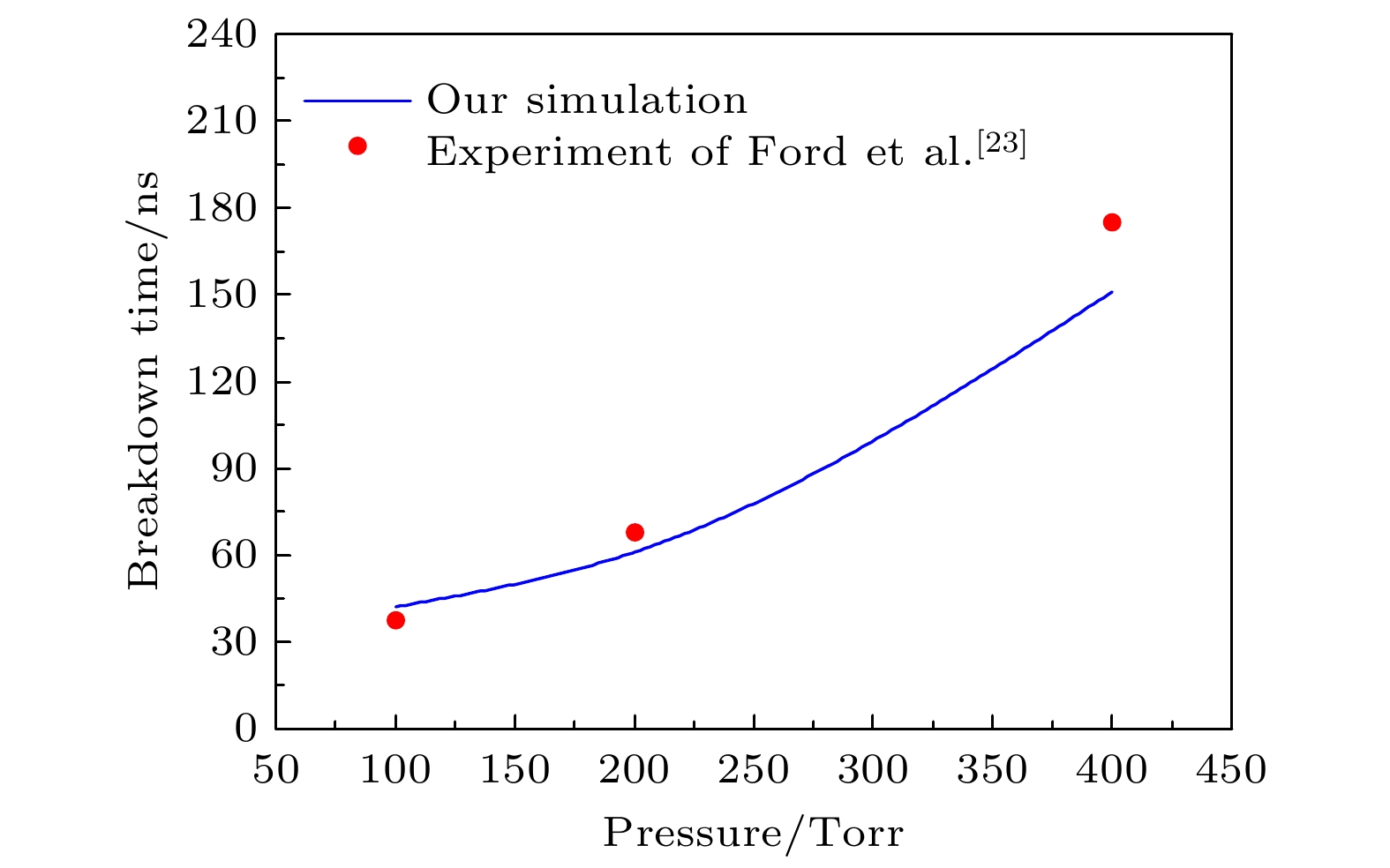-
在高功率微波介质窗外表面周围, 气体击穿是限制功率容量提升的主要因素之一, 因此进行相应的模拟研究具有重要的意义. 本文通过粒子-蒙特卡罗碰撞模型对介质窗气体侧击穿特性进行了模拟研究. 将宏粒子合并方法引入该模型, 大大减少了跟踪的宏粒子数量, 以至于能够对整个击穿过程进行模拟与分析. 结果表明, 在宏粒子权重为变量下, 击穿的时空演化特性与宏粒子权重为常数下的结果符合得很好. 由于次级电子发射产额远小于1, 所以气体电离是介质窗气体侧击穿的主导机理. 电子电离和扩散导致等离子体的密度和厚度随着时间显著增加. 电子密度的峰值未出现在介质表面处而是在距离介质表面100—150 μm的位置. 这是因为大量的电子沉积在介质表面上, 伴随产生的自组织法向电场驱使电子远离介质表面. 由于本文关注的背景气体压强高于最大电离率对应的临界压强(约为1.33 × 103 Pa ), 所以电离率随着压强的增加而单调减小, 并导致击穿发展得更加缓慢. 通过比较击穿时间的模拟值与实验数据, 证实了粒子-蒙特卡罗碰撞模型的准确性.
-
关键词:
- 气体击穿 /
- 介质表面 /
- 高功率微波 /
- 粒子-蒙特卡罗碰撞模型 /
- 宏粒子合并方法
Gas breakdown is one of the key factors limiting the increase of power capacity of the outer surface of high-power microwave dielectric window. It is of great significance to conduct corresponding simulation studies. Compared with the fluid model, the particle-in-cell-Monte Carlo collision model has two advantages. One is that the influence of numerical dispersion and instability problems is insignificant, and the other is that it can accurately describe microphysical processes. Therefore, the breakdown characteristics on the gas side of dielectric window are simulated by using the particle-in-cell-Monte Carlo collision model. The two-in-one macro-particle merging method is introduced into the model, thereby greatly reducing the number of macro-particles tracked. Therefore, the whole breakdown process can be simulated and analyzed. The results show that the spatial and temporal evolution of breakdown under the variable macro-particle weight is in good agreement with that under the constant macro-particle weight. This suggests that the two-in-one macro-particle merging method is applicable under the simulation conditions of interest in this paper, i.e., when the ratio of the effective electric field of microwaves to the pressure is between $1.76\times10^3$ and $1.41\times10^4$ V/(m$\cdot$Torr). Since the yield of the secondary electron emission is much less than 1, gas ionization is the dominant mechanism of breakdown on the gas side of dielectric window. Electron ionization and electron diffusion lead the density and thickness of the plasma to significantly increase over time. The peak of electron density does not appear at the dielectric surface, but at a position of 100–150 μm away from the dielectric surface. This is because a large number of electrons are deposited on the dielectric surface, and the accompanying self-organized normal electric field drives the electrons away from the dielectric surface. Because the pressure of background gas of interest in this work is higher than the critical pressure corresponding to the maximum ionization rate (about 10 Torr), the ionization rate decreases monotonically with pressure increasing, resulting in a slower development of breakdown. The accuracy of the particle-in-cell-Monte Carlo collision model is confirmed by comparing the simulated values of breakdown time with experimental data. This work provides an important theoretical basis for understanding and controlling the breakdown on the gas side of dielectric window. The following figure (a) shows that the mean electron energy under the variable macro-particle weight agrees well with that under the constant macro-particle weight at about 100 Torr. The following figure (b) shows that when the plasma density is increased by a factor of 108, the breakdown process can be considered by using the particle-in-cell-Monte Carlo collision model and a two-in-one macro-particle merging method.-
Keywords:
- gas breakdown /
- dielectric surface /
- high-power microwave /
- particle-in-cell-Monte Carlo collision model /
- macro-particle merging method
[1] Schaub S C, Shapiro M A, Temkin R J 2019 Phys. Rev. Lett. 123 175001
 Google Scholar
Google Scholar
[2] 杨浩, 黄诺慈, 刘星辰, 郑强林, 鲍向阳, 闫二艳 2024 强激光与粒子束 36 043031
 Google Scholar
Google Scholar
Yang H, Huang N C, Liu X C, Zheng Q L, Bao X Y, Yan E Y 2024 High Power Laser and Particle Beams 36 043031
 Google Scholar
Google Scholar
[3] Wen D Q, Zhang P, Krek J, Fu Y, Verboncoeur J P 2022 Phys. Rev. Lett. 129 045001
 Google Scholar
Google Scholar
[4] Chang C, Fang J Y, Zhang Z Q, Chen C, Tang C, Jin Q 2010 Appl. Phys. Lett. 97 141501
 Google Scholar
Google Scholar
[5] Zhao P, Wang R, Guo L 2022 Plasma Sources Sci. Technol. 31 095005
 Google Scholar
Google Scholar
[6] Wang H, Liu L, Liu D, Meng L 2022 IEEE Trans. Electron Dev. 69 4598
 Google Scholar
Google Scholar
[7] Kim H C, Verboncoeur J P 2006 Phys. Plasmas 13 123506
 Google Scholar
Google Scholar
[8] 蔡利兵, 王建国 2010 物理学报 59 1143
 Google Scholar
Google Scholar
Cai L B, Wang J G 2010 Acta Phys. Sin. 59 1143
 Google Scholar
Google Scholar
[9] 董烨, 董志伟, 周前红, 杨温渊, 周海京 2014 物理学报 63 067901
 Google Scholar
Google Scholar
Dong Y, Dong Z W, Zhou Q H, Yang W Y, Zhou H J 2014 Acta Phys. Sin. 63 067901
 Google Scholar
Google Scholar
[10] 常超 2018 科学通报 63 1391
Chang C 2018 Chin Sci. Bull. 63 1391
[11] 左春彦, 高飞, 戴忠玲, 王友年 2018 物理学报 67 225201
 Google Scholar
Google Scholar
Zuo C Y, Gao F, Dai Z L, Wang Y N 2018 Acta Phys. Sin. 67 225201
 Google Scholar
Google Scholar
[12] 舒盼盼, 赵朋程, 王瑞 2023 物理学报 72 095202
 Google Scholar
Google Scholar
Shu P P, Zhao P C, Wang R 2023 Acta Phys. Sin. 72 095202
 Google Scholar
Google Scholar
[13] Iqbal A, Wen D Q, Verboncoeur J, Zhang P 2023 High Voltage 8 1095
 Google Scholar
Google Scholar
[14] Zhao P, Liu Z, Wang R, Shu P, Guo L, Cao X 2024 Plasma Sci. Technol. 26 045401
 Google Scholar
Google Scholar
[15] 孟祥琛, 王丹, 蔡亚辉, 叶振, 贺永宁, 徐亚男 2023 物理学报 72 107901
 Google Scholar
Google Scholar
Meng X C, Wang D, Cai Y H, Ye Z, He Y N, Xu Y N 2023 Acta Phys. Sin. 72 107901
 Google Scholar
Google Scholar
[16] Hu T, Zhu S, Zhao Y, Sun X, Yang J, He Y, Wang X, Bai C, Bai H, Wei H, Cao M, Hu Z, Liu M, Cui W 2022 Chin. Phys. B 31 047901
 Google Scholar
Google Scholar
[17] Chang C, Liu G, Tang C, Chen C, Fang J 2011 Phys. Plasmas 18 055702
 Google Scholar
Google Scholar
[18] Chang C, Liu Y S, Verboncoeur J, Chen C H, Guo L T, Li S, Wu X L 2015 Appl. Phys. Lett. 106 014102
 Google Scholar
Google Scholar
[19] Langellotti S V, Brusstar A, Jordan N M, Lau Y Y, Gilgenbach R M 2023 IEEE Trans. Electron Dev. 70 5871
 Google Scholar
Google Scholar
[20] Zuo C Y, Gao F, Dai Z L, Wang Y N 2023 Phys. Plasmas 30 062101
 Google Scholar
Google Scholar
[21] Wen D Q, Iqbal A, Zhang P, Verboncoeur J P 2022 Appl. Phys. Lett. 121 164103
 Google Scholar
Google Scholar
[22] Zhang J, Jiang M, Luo W, Wang H, Li Y, Liu C 2020 J. Appl. Phys. 128 143301
 Google Scholar
Google Scholar
[23] Ford P J, Beeson S R, Krompholz H G, Neuber A A 2012 Phys. Plasmas 19 073503
 Google Scholar
Google Scholar
[24] 周前红, 董烨, 董志伟, 周海京 2015 物理学报 64 085201
 Google Scholar
Google Scholar
Zhou Q H, Dong Y, Dong Z W, Zhou H J 2015 Acta Phys. Sin. 64 085201
 Google Scholar
Google Scholar
[25] Teunissen J, Ebert U 2014 J. Comput. Phys. 259 318
 Google Scholar
Google Scholar
[26] Peterson L R, Allen J E 1972 J. Chem. Phys. 56 6068
 Google Scholar
Google Scholar
[27] Vaughan J R M 1989 IEEE Trans. Electron Devices 36 1963
 Google Scholar
Google Scholar
[28] Lau Y Y, Verboncoeur J P, Kim H C 2006 Appl. Phys. Lett. 89 261501
 Google Scholar
Google Scholar
-
图 2 在背景气体压强为100 Torr和宏粒子权重分别为变量与常数下, (a)平均电子能量, 微波电场以及(b)电子数量随时间的变化
Fig. 2. The change of (a) mean electron energy, microwave electric field, and (b) number of electrons over time with the macro-particle weights as variables and constant, respectively. The background gas pressure is 100 Torr in this figure.
图 3 在背景气体压强为100 Torr和宏粒子权重分别为变量与常数下, $ t=2.5\; {\mathrm{ns}}$时的电子数密度随坐标z的变化
Fig. 3. The variation of electron number density with coordinate z at time $ t=2.5\; {\mathrm{ns}}$ when the weights of macro–particles are variables and a constant, respectively. The background gas pressure is 100 Torr in this figure.
-
[1] Schaub S C, Shapiro M A, Temkin R J 2019 Phys. Rev. Lett. 123 175001
 Google Scholar
Google Scholar
[2] 杨浩, 黄诺慈, 刘星辰, 郑强林, 鲍向阳, 闫二艳 2024 强激光与粒子束 36 043031
 Google Scholar
Google Scholar
Yang H, Huang N C, Liu X C, Zheng Q L, Bao X Y, Yan E Y 2024 High Power Laser and Particle Beams 36 043031
 Google Scholar
Google Scholar
[3] Wen D Q, Zhang P, Krek J, Fu Y, Verboncoeur J P 2022 Phys. Rev. Lett. 129 045001
 Google Scholar
Google Scholar
[4] Chang C, Fang J Y, Zhang Z Q, Chen C, Tang C, Jin Q 2010 Appl. Phys. Lett. 97 141501
 Google Scholar
Google Scholar
[5] Zhao P, Wang R, Guo L 2022 Plasma Sources Sci. Technol. 31 095005
 Google Scholar
Google Scholar
[6] Wang H, Liu L, Liu D, Meng L 2022 IEEE Trans. Electron Dev. 69 4598
 Google Scholar
Google Scholar
[7] Kim H C, Verboncoeur J P 2006 Phys. Plasmas 13 123506
 Google Scholar
Google Scholar
[8] 蔡利兵, 王建国 2010 物理学报 59 1143
 Google Scholar
Google Scholar
Cai L B, Wang J G 2010 Acta Phys. Sin. 59 1143
 Google Scholar
Google Scholar
[9] 董烨, 董志伟, 周前红, 杨温渊, 周海京 2014 物理学报 63 067901
 Google Scholar
Google Scholar
Dong Y, Dong Z W, Zhou Q H, Yang W Y, Zhou H J 2014 Acta Phys. Sin. 63 067901
 Google Scholar
Google Scholar
[10] 常超 2018 科学通报 63 1391
Chang C 2018 Chin Sci. Bull. 63 1391
[11] 左春彦, 高飞, 戴忠玲, 王友年 2018 物理学报 67 225201
 Google Scholar
Google Scholar
Zuo C Y, Gao F, Dai Z L, Wang Y N 2018 Acta Phys. Sin. 67 225201
 Google Scholar
Google Scholar
[12] 舒盼盼, 赵朋程, 王瑞 2023 物理学报 72 095202
 Google Scholar
Google Scholar
Shu P P, Zhao P C, Wang R 2023 Acta Phys. Sin. 72 095202
 Google Scholar
Google Scholar
[13] Iqbal A, Wen D Q, Verboncoeur J, Zhang P 2023 High Voltage 8 1095
 Google Scholar
Google Scholar
[14] Zhao P, Liu Z, Wang R, Shu P, Guo L, Cao X 2024 Plasma Sci. Technol. 26 045401
 Google Scholar
Google Scholar
[15] 孟祥琛, 王丹, 蔡亚辉, 叶振, 贺永宁, 徐亚男 2023 物理学报 72 107901
 Google Scholar
Google Scholar
Meng X C, Wang D, Cai Y H, Ye Z, He Y N, Xu Y N 2023 Acta Phys. Sin. 72 107901
 Google Scholar
Google Scholar
[16] Hu T, Zhu S, Zhao Y, Sun X, Yang J, He Y, Wang X, Bai C, Bai H, Wei H, Cao M, Hu Z, Liu M, Cui W 2022 Chin. Phys. B 31 047901
 Google Scholar
Google Scholar
[17] Chang C, Liu G, Tang C, Chen C, Fang J 2011 Phys. Plasmas 18 055702
 Google Scholar
Google Scholar
[18] Chang C, Liu Y S, Verboncoeur J, Chen C H, Guo L T, Li S, Wu X L 2015 Appl. Phys. Lett. 106 014102
 Google Scholar
Google Scholar
[19] Langellotti S V, Brusstar A, Jordan N M, Lau Y Y, Gilgenbach R M 2023 IEEE Trans. Electron Dev. 70 5871
 Google Scholar
Google Scholar
[20] Zuo C Y, Gao F, Dai Z L, Wang Y N 2023 Phys. Plasmas 30 062101
 Google Scholar
Google Scholar
[21] Wen D Q, Iqbal A, Zhang P, Verboncoeur J P 2022 Appl. Phys. Lett. 121 164103
 Google Scholar
Google Scholar
[22] Zhang J, Jiang M, Luo W, Wang H, Li Y, Liu C 2020 J. Appl. Phys. 128 143301
 Google Scholar
Google Scholar
[23] Ford P J, Beeson S R, Krompholz H G, Neuber A A 2012 Phys. Plasmas 19 073503
 Google Scholar
Google Scholar
[24] 周前红, 董烨, 董志伟, 周海京 2015 物理学报 64 085201
 Google Scholar
Google Scholar
Zhou Q H, Dong Y, Dong Z W, Zhou H J 2015 Acta Phys. Sin. 64 085201
 Google Scholar
Google Scholar
[25] Teunissen J, Ebert U 2014 J. Comput. Phys. 259 318
 Google Scholar
Google Scholar
[26] Peterson L R, Allen J E 1972 J. Chem. Phys. 56 6068
 Google Scholar
Google Scholar
[27] Vaughan J R M 1989 IEEE Trans. Electron Devices 36 1963
 Google Scholar
Google Scholar
[28] Lau Y Y, Verboncoeur J P, Kim H C 2006 Appl. Phys. Lett. 89 261501
 Google Scholar
Google Scholar
计量
- 文章访问数: 3333
- PDF下载量: 61
- 被引次数: 0














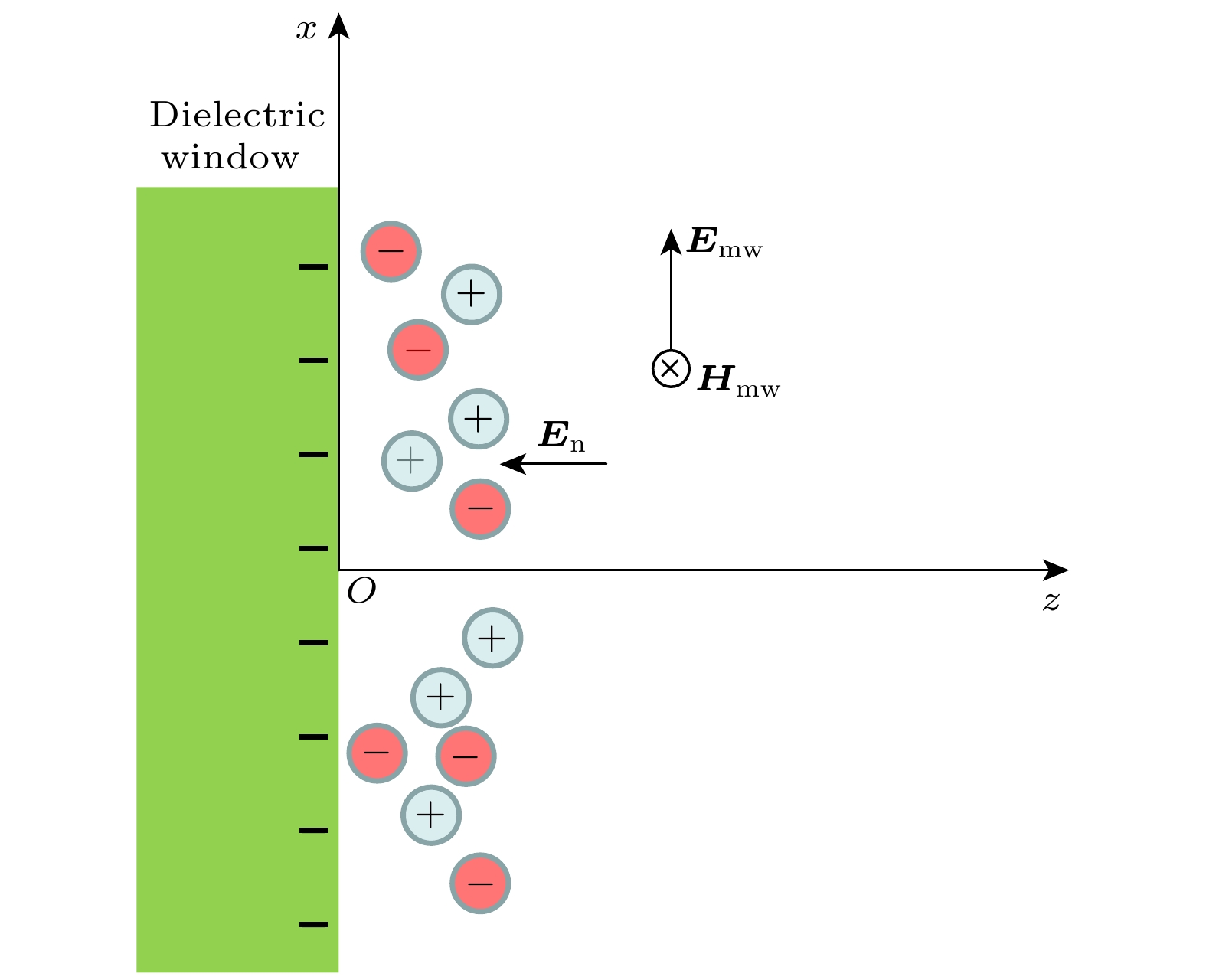
 下载:
下载:
